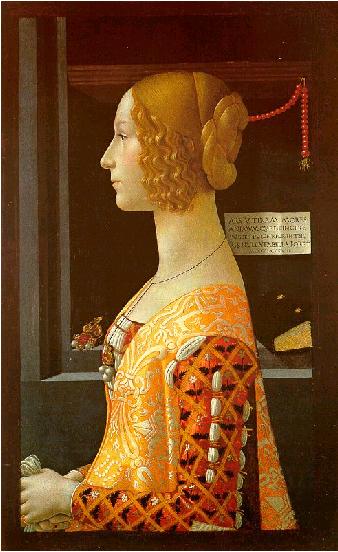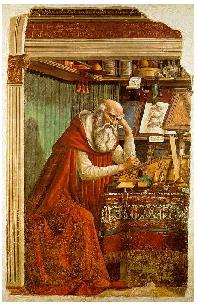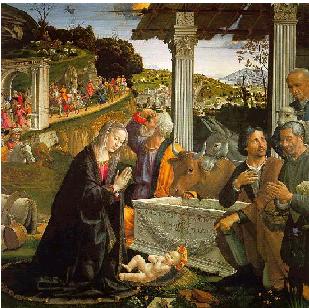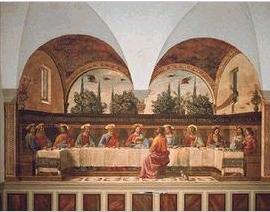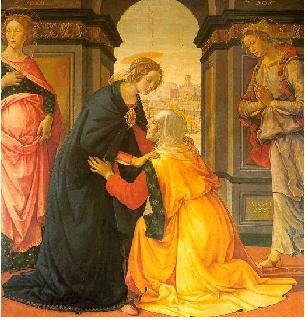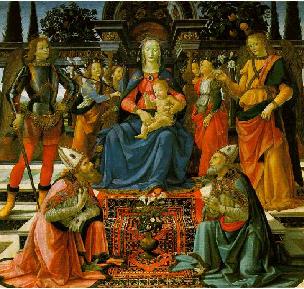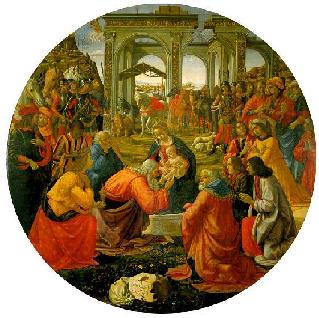
Candida Martinelli's Italophile Site

Main
Page This family-friendly site celebrates Italian culture for the enjoyment of children and
adults. Site-Overview
Knights of Art -
Ghirlandaio
Visit
my Angels in Italian Art Page
Visit
my Canaletto and Venice Art Page On-line images of art at Web
Gallery of Art: Ghirlandaio!
What a difficult name that sounds to our English ears. But it has a very
simple meaning, and when you understand it the difficulty will vanish. It
all happened in this way. Domenico's father was a goldsmith, one of the
cleverest goldsmiths in Florence, and he was specially famous for making
garlands or wreaths of gold and silver. It was the fashion then for the
young maidens of Florence to wear these garlands, or `ghirlande' as they
were called, on their heads, and because this goldsmith made them better
than any one else they gave him the name of Ghirlandaio, which means
`maker of garlands,' and that became the family name. Portrait of Giovanna
Tornabuoni by Ghirlandaio When
the time came for the boy Domenico to learn a trade, he was sent, of
course, to his father's workshop. He learned so quickly, and worked with
such strong, clever fingers, that his father was delighted. `The
boy will make the finest goldsmith of his day,' he said proudly, as he
watched him twisting the delicate golden wire and working out his
designs in beaten silver. So
he was set to make the garlands, and for a while be was contented and
happy. It was such exquisite work to twine into shape the graceful
golden leaves, with here and there a silver lily or a jewelled rose, and
to dream of the fair head on which the garland would rest. But
the making of garlands did not satisfy Domenico for long, and like
Botticelli he soon began to dream of becoming a painter. St. Jerome in his Study by
Ghirlandaio You
must remember that in those days goldsmiths and painters had much in
common, and often worked together. The goldsmith made his picture with
gold and silver and jewels, while the painter drew his with colours, but
they were both artists. So
as the young Ghirlandaio watched these men draw their great designs and
listened to their talk, he began to feel that the goldsmith's work was
cramped and narrow, and he longed for a larger, grander work. Day by day
the garlands were more and more neglected, and every spare moment was
spent drawing the faces of those who came to the shop, or even those of
the passers-by. But
although, ere long, Ghirlandaio left his father's shop and learned to
make pictures with colours, instead of with gold, silver, and jewels,
still the training he had received in his goldsmith's work showed to the
end in all his pictures. He painted the smallest things with extreme
care, and was never tired of spreading them over with delicate ornaments
and decorations. It is a great deal the outward show with Ghirlandaio,
and not so much the inward soul, that we find in his pictures, though he
had a wonderful gift of painting portraits. These
portraits painted by the young Ghirlandaio
seemed very wonderful to the admiring Florentines. From all his
pictures looked out faces which they knew and recognised immediately.
There, in a group of saints, or in a crowd of figures around the Infant
Christ, they saw the well-known faces of Florentine nobles, the great
ladies from the palaces, ay, and even the men of the market-place, and
the poor peasant women who sold eggs and vegetables in the streets. Once
he painted an old bishop with a pair of spectacles resting on his nose.
It was the first time that spectacles had ever been put into a picture. The Nativity by Ghirlandaio Then
off he must go to Rome, like every one else, to add his share to the
famous frescoes of the Vatican. But it was in Florence that most of his
work was done. In
the church of Santa Maria Novella there was a great chapel which
belonged to the Ricci family. It had once been covered by beautiful
frescoes, but now it was spoilt by damp and the rain that came through
the leaking roof. The noble family, to whom the chapel belonged, were
poor and could not afford to have the chapel repainted, but neither
would they allow any one else to decorate it, lest it should pass out of
their hands. Now
another noble family, called the Tournabuoni, when they heard of the
fame of the new painter, greatly desired to have a chapel painted by him
in order to do honour to their name and family. Accordingly
they went to the Ricci family and offered to have the whole chapel
painted and to pay the
artist themselves. Moreover, they said that the arms or crest of the
Ricci family should be painted in the most honourable part of the
chapel, that all might see that the chapel still belonged to them. To
this the Ricci family gladly agreed, and Ghirlandaio was set to work to
cover the walls with his frescoes. `I
will give thee twelve hundred gold pieces when it is done,' said
Giovanni Tournabuoni, `and if I like it well, then shalt thou have two
hundred more.' Here
was good pay indeed. Ghirlandaio set to work with all speed, and day by
day the frescoes grew. For four years he worked hard, from morning until
night, until at last the walls were covered. The Last Supper by Ghirlandaio One
of the subjects which he chose for these frescoes was the story of the
Life of the Virgin, so often painted by Florentine artists. This story I
will tell you now, that your eyes may take greater pleasure in the
pictures when you see them. The
Bible story of the Virgin Mary begins when the Angel Gabriel came to
tell her of the birth of the Baby Jesus, but there are many stories or
legends about her before that time, and this is one which the Italians
specially loved to paint. Among
the blue hills of Galilee, in the little town of Nazareth, there lived a
man and his wife whose names were Joachim and Anna. Though they were
rich and had many flocks of sheep which fed in the rich pastures around,
still there was one thing which God had not given them and which they
longed for more than all beside. They had no child. They had hoped that
God would send one, but now they were both growing old, and hope began
to fade. Joachim
was a very good man, and gave a third of all that he had as an offering
to the temple; but one sad day when he took his gift, the high priest at
the altar refused to take it. `God
has shown that He will have nought of thee,' said the priest, `since
thou hast no child to come after thee.' Filled
with shame and grief Joachim would not go home to his wife, but instead
he wandered out into the far-of fields where his shepherds were feeding
the flocks, and there he stayed forty days. With bowed head and sad eyes
when he was alone, he knelt and prayed that God would tell him what he
had done to deserve this disgrace. The Visitation by Ghirlandaio And
as he prayed God sent an angel to comfort him. The
angel placed his hand upon the bowed head of the poor old man, and told
him to be of good cheer and to return home at once to his wife. `For
God will even now send thee a child,' said the angel. So
with a thankful heart which never doubted the angel's word, Joachim
turned his face homewards. Meanwhile,
at home, Anna had been sorrowing alone. That same day she had gone into
the garden, and, as she wandered among the flowers, she wept bitterly
and prayed that God would send her comfort. Then there appeared to her
also an angel, who told her that God had heard her prayer and would send
her the child she longed for. `Go
now,' the angel added, `and meet thy husband Joachim, who is even now
returning to thee, and thou shall find him at the entrance to the Golden
Gate.' So
the husband and wife did as the angel bade them, and met together at the
Golden Gate. And the Angel of Promise hovered above them, and laid a
hand in blessing upon both their heads. There
was no need for speech. As Joachim and Anna looked into each other's
eyes and read there the solemn joy of the angel's message, their hearts
were filled with peace and comfort. And
before long the angel's promise was fulfilled, and a little daughter was
born to Anna and Joachim. In their joy and thankfulness they said she
should not be as other children, but should serve in the temple as
little Samuel had done. The name they gave the child was Mary, not
knowing even then that she was to be the mother of our Lord. Christ in Heaven by
Ghirlandaio The
little maid was but three years old when her parents took her to present
her in the temple. She was such a little child that they almost feared
she might be frightened to go up the steps to the great temple and meet
the high priest alone. So they asked if she might go in company with the
other children who were also on their way to the temple. But when the
little band arrived at the temple steps, Mary stepped forward and began
to climb up, step by step, alone, while the other children and her
parents watched wondering from below. Straight up to the temple gates
she climbed, and stood with little head bent low to receive the blessing
of the great high priest. So
the child was left there to be taught to serve God and to learn how to
embroider the purple and fine linen for the priests' vestments. Never
before had such exquisite embroidery been done as that which Mary's
fingers so delicately stitched, for her work was aided by angel hands.
Sleeping or waking, the blessed angels never left her. When
it was time that the maiden should be married, so many suitors came to
seek her that it was difficult to know which to choose. To decide the
matter they were all told to bring their staves or wands and leave them
in the temple all night, that God might show by a sign who was the most
worthy to be the guardian of the pure young maid. Now
among the suitors was a poor carpenter of Nazareth called Joseph, who
was much older and much poorer than any of the other suitors. They
thought it was foolish of him to bring his staff, nevertheless it was
placed in the temple with the others. But
when the morning came and the priest went into the temple, behold,
Joseph's staff had budded into leaves and flowers, and from among the
blossoms there flew out a dove as white as snow. Madonna Enthroned with Saints
by Ghirlandaio So
it was known that Joseph was to take charge of the young maid, and all
the rest of the suitors seized their staves and broke them across their
knees in rage and disappointment. Then
the story goes on to the birth of our Saviour as it is told to you in
the Bible. It
was this story which Ghirlandaio painted on the walls of the chapel, as
well as the history of John the Baptist. Then, as Giovanni directed, he
painted the arms of the Tournabuoni on various shields all over the
chapel, and only in the tabernacle of the sacrament on the high altar he
painted a tiny coat of arms of the Ricci family. The
chapel was finished at last and every one flocked to see it, but first
of all came the Ricci, the owners of the chapel. They
looked high and low, but nowhere could they see the arms of their
family. Instead, on all sides, they saw the arms of the Tournabuoni. In
a great rage they hurried to the Council and demanded that Giovanni
Tournabuoni should be punished. But when the facts were explained, and
it was shown that the Ricci arms had indeed been placed in the most
honourable part, they were obliged to be content, though they vowed
vengeance against the Tournabuoni. Neither did Ghirlandaio get his extra
two hundred gold pieces, for although Giovanni was delighted with the
frescoes he never paid the price he had promised. To
the end of his days Ghirlandaio loved nothing so much as to work from
morning till night. Nothing was too small or mean for him to do. He
would even paint the hoops for women's baskets rather than send any work
away from his shop. `Oh,'
he cried, one day, `how I wish I could paint all the walls around
Florence with my stories.' Adoration of the Magi by
Ghirlandaio But
there was no time to do all that. He was only forty-four years old when
Death came and bade him lay down his brushes and pencil, for his work
was done.
Return to:
Stories of the Italian Painters
by Amy Steedman
